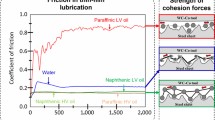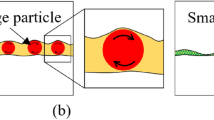Conclusions
1. Self-lubricating materials of the existing range mostly have low resistance to microbial attack.
2. This applies especially to the basic components — Kapron, Kaprolon, fluoroplastic, resin bases without fillers.
3. The introduction of fillers and binders modifies the resistance of the basic ingredients; filling fluoroplastics, Kapron, and resins with graphite, coke, metals, or alloys considerably improves the resistance of the self-lubricating compound, whereas using certain organic resins (phenol-formaldehyde, urea-formaldehyde) as binders leads to a fall in the microbial resistance of the lubricating coating.
4. Lubricating coatings with silicone or inorganic (including silicate) binders, graphite-filled fluoroplastics and metal-filled graphites, carboplastics, polyarylates, and Maslyanits display the greatest ability to resist microbial attack; these materials are chemically unassimilable by the microbial cell. They can be recommended for use in the tropics without an antimicrobial additive.
5. Materials with low resistance under tropical conditions require protection with antimicrobial additives. However, whether or not it is advisable to develop an additive depends in each case on the technical justifiability of using the material in question, its cost-effectiveness, and many other factors. In our opinion, it is not worthwhile developing additives for basic materials (fluoroplastic, Kapron, Kaprolon, certain resins) since there are resistant substitutes available (metal-filled graphite, Maslyanits, AMAN, etc.). As for such a promising material as MFPL, with its unique combination of properties, the search for antimicrobial additives appears to us to be both technically and economically justified.
Similar content being viewed by others
Literature cited
L. N. Sentyurikhina and E. M. Oparina, Molybdenum Disulfide Solid Lubricants [in Russian], Moscow (1966).
E. R. Braithwaite, Solid Lubricants and Surfaces, Pergamon (1964).
A. P. Semenov and R. M. Matveevskii, "Physicochemical and antifriction properties of self-lubricating bearing materials containing Ftoroplast-4," in: Structural Properties of Plastics [in Russian], Moscow (1968), pp. 71–93.
V. É. Vainshtein and G. I. Troyanovskaya, Dry Lubricants and Self-lubricating Materials [in Russian], Moscow (1968).
G. Ya. Vorob'eva, Corrosion Resistance of Materials to Aggressive Media Used in the Chemical Industry [in Russian], Moscow (1975).
V. Blagnik and V. Zanova, Microbiological Corrosion [in Russian], Moscow (1965).
I. M. Lyubarskii, G. V. Kurilov, L. N. Sentyurikhina, and V. F. Udovenko, "Antifriction properties of solid lubricating coatings," in: Problems of Friction and Wear [in Russian], No. 1, Kiev (1971), pp. 44–68.
G. I. Troyanovskaya, "Use of self-lubricating materials in rotaprint lubrication," Vestn. Mashinostr., No. 4, 51–56 (1974).
Yu. A. Zybin and N. I. Samosatskii, Filled Fluoroplastics [in Russian], Kiev (1965).
Yu. S. Lipatov, Physicochemistry of Filled Polymers [in Russian], Kiev (1967).
A. P. Semenov, "Metal-filled fluoroplastic bearing materials for heavy friction regimes with no or insufficient lubrication," in: Wear Resistance [in Russian], Moscow (1975), pp. 58–70.
Yu. É. Savinskii and A. P. Semenov, "Investigation of self-lubricating metal-filled fluoroplastic bearings for use in oscillating friction units," in: Problems of Friction and Wear [in Russian], No. 2, Kiev (1972), pp. 85–99.
D. N. Garkunov and A. A. Polyakov, Improving the Wear Resistance of Aircraft Structural Components [in Russian], Moscow (1974).
Additional information
Kiev Technological Institute of the Food Industry. Translated from Mekhanika Polimerov, No. 6, pp. 1011–1016, November–December, 1977.
Rights and permissions
About this article
Cite this article
Litvinenko, S.N., Preis, G.A. Comparative microbiological resistance of various self-lubricating materials. Polymer Mechanics 13, 843–847 (1977). https://doi.org/10.1007/BF00866990
Received:
Issue Date:
DOI: https://doi.org/10.1007/BF00866990




